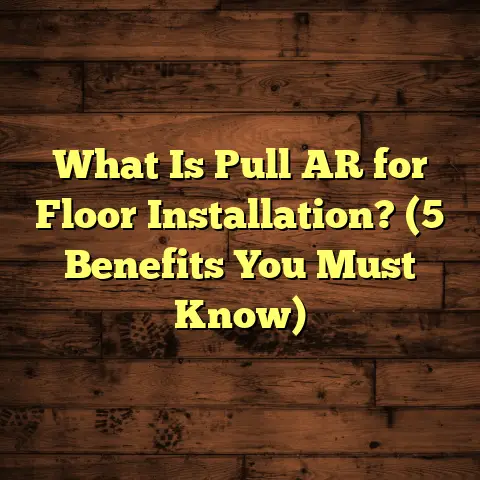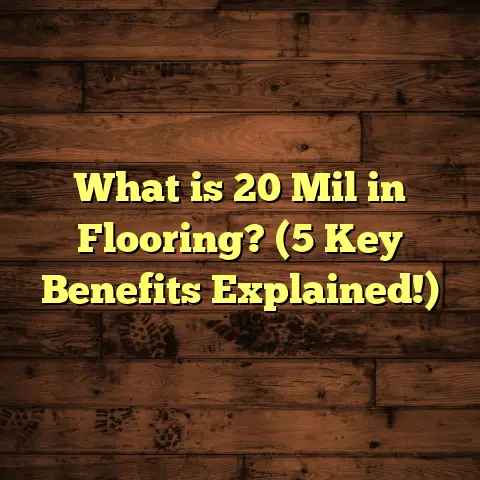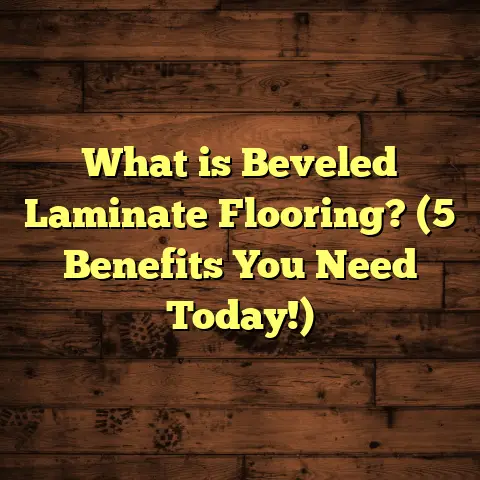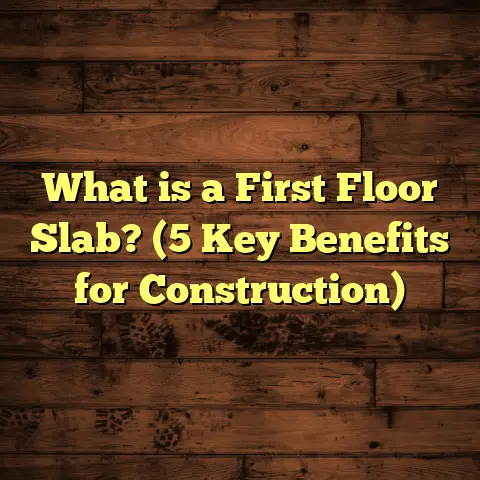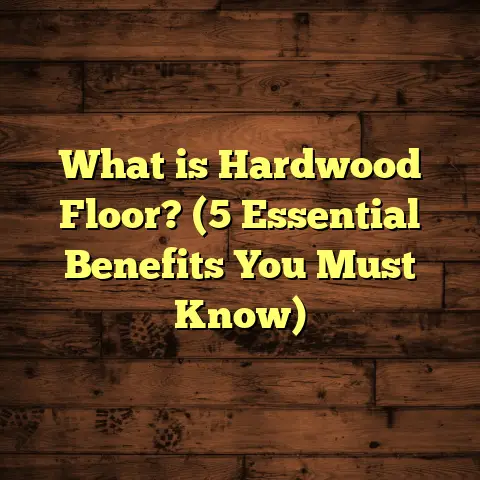What is the Least Expensive Flooring? (5 Budget-Friendly Options)
I remember the first time I had to pick flooring for my own place — and boy, was I overwhelmed. You’d think it’s just about choosing a pretty floor, right? But it quickly became clear that there’s so much more to it. What’s affordable? What’s durable? How long will it last? And how much will installation cost? I had a budget but wanted something that wouldn’t look like I skimped on it. If you’ve been there, you know this can feel like a puzzle with a million pieces.
So, I decided to get serious about finding the least expensive flooring options that still do their job well. I dug into different materials, prices, installation methods, and maintenance needs. Along the way, I learned a ton and faced some head-scratchers. Today I want to share that journey with you — the good, the tricky, and everything in between.
Let’s start by answering the basic question…
What Is the Least Expensive Flooring?
When people ask me this, they often mean: “What flooring costs the least upfront?” But I like to think about cost a bit differently. Sure, price per square foot matters, but what about installation? Maintenance? How long it lasts before you need to replace it?
So, the least expensive flooring is a balance — something affordable to buy and install that holds up well enough not to drive up your costs later.
Here’s why this balance is key: say you find an ultra-cheap floor costing $0.50 per square foot. Great deal, right? But if it lasts only two years before you have to rip it out and redo it, you’ve actually spent more over time than someone who bought a $3 floor lasting 20 years.
That’s why I don’t just chase the cheapest material; I look for value. Value means cost-effectiveness over the life of the floor.
What Factors Affect Flooring Cost?
- Material price: This is usually the headline figure.
- Installation cost: Labor or tools needed to put it down.
- Preparation work: Does the subfloor need fixing or leveling?
- Maintenance: Some floors require special cleaners or refinishing.
- Lifespan: How many years before it needs replacement.
- Waste factor: Extra material needed due to cuts or mistakes.
With those in mind, here are the five budget-friendly flooring options I’ve worked with and recommend for different situations:
Vinyl Flooring: Affordable and Adaptable
Vinyl has been a staple in affordable flooring for decades. At first glance, some might dismiss it as cheap or plasticky. But today’s vinyl options — especially luxury vinyl planks (LVP) or tiles (LVT) — have come a long way in style and durability.
Why Vinyl Is Often My First Suggestion
- Material cost: Basic vinyl sheet flooring can be found for as low as $1 per square foot. Luxury vinyl planks generally range from $2 to $5 per square foot.
- Installation: Vinyl sheets can be glued down, but LVP/LVT often uses click-lock systems that make DIY installation possible.
- Water resistance: Vinyl handles moisture far better than laminate or wood.
- Durability: Good quality vinyl resists scratches and dents reasonably well.
- Variety: You get an amazing range of looks — from wood grain to stone textures.
My Vinyl Installation Stories
I once tackled a kitchen remodel in my own home where budget was tight but style mattered. I went with luxury vinyl planks that looked like hardwood for about $2.50/sq ft in materials and installed them myself over the existing subfloor. The total cost including tools was under $1,000 for 400 square feet.
The installation took me a weekend and several evenings after work. It wasn’t without headaches though — cutting planks precisely around corners and appliances required patience and extra blades. But the results? The kitchen felt warm and inviting without spending thousands.
In another project for a rental property, I used cheaper vinyl sheet flooring at about $1.50/sq ft plus professional installation. It saved money but didn’t hold up quite as well long-term — after a year, some seams started peeling due to wear by tenants.
Challenges with Vinyl
The biggest issue with very cheap vinyl is durability. Thin sheets can tear or dent under heavy furniture or sharp objects. Also, installing vinyl sheets perfectly flat can be tough if your subfloor isn’t even.
Pro Tip: Always add a waste factor of about 7–10% when ordering vinyl because cuts around corners and irregular spaces add up quickly.
Laminate Flooring: Budget-Friendly Wood Lookalike
Laminate flooring has been around for years as an affordable alternative to hardwood. It has its fans and detractors — some love how easy it is to install and maintain; others complain about its sensitivity to moisture.
What Makes Laminate Popular?
- Cost: Laminate generally runs between $1.50 and $3 per square foot.
- Installation: The floating click-lock design means many homeowners install it themselves.
- Appearance: Modern laminates can mimic real wood with impressive detail.
- Maintenance: Easy cleaning but vulnerable to water damage if spills aren’t wiped fast.
My Basement Renovation Experience with Laminate
I helped a friend finish their basement using laminate flooring. It was a budget-conscious choice because hardwood wasn’t feasible in this moisture-prone area.
The laminate looked great initially and gave the space warmth that concrete couldn’t provide. However, after a few minor flooding incidents, some boards swelled and warped despite using underlayment with moisture barrier. We ended up replacing those sections after two years.
I also learned that not all laminates are created equal — higher-end brands offer better protection against moisture but cost more upfront.
Data on Laminate Lifespan
According to a 2023 flooring industry report, laminate floors average about 15 years of lifespan in residential settings when properly installed and maintained.
Ceramic & Porcelain Tile: Budget Choices for Wet Areas
Tiles often get a reputation for being expensive because of high-end marble or designer options. But basic ceramic and porcelain tiles are quite affordable and very durable — especially where water resistance matters.
Why Choose Tile?
- Cost: Basic ceramic tiles can start around $1 per square foot; porcelain is often slightly higher.
- Durability: Tiles last decades if installed right.
- Water resistance: Ideal for bathrooms, kitchens, laundry rooms.
- Maintenance: Easy to clean but grout lines need sealing periodically.
My Commercial Tile Project
Once I managed a small café fit-out where budget was tight but floors had to handle heavy foot traffic and spills daily. We selected mid-range porcelain tiles at about $2/sq ft plus skilled labor installation.
The tiles held up great for years but we noticed tiny chips at edges after heavy use by carts and deliveries. The owner learned that investing slightly more in thicker or tougher tile could reduce these issues.
Installation Challenges with Tile
Tile installation requires skill — proper subfloor prep, precise cuts, leveling, and grout application are essential. Labor costs often exceed materials costs here, sometimes doubling total expense.
Tip: Factor in about 10–15% waste due to cuts and breakage during installation.
Carpet: Affordable Comfort Underfoot
Carpet sometimes gets overlooked because of concerns about stains or upkeep. But budget carpet options can be surprisingly inexpensive while adding warmth and soundproofing.
Why Carpet?
- Cost: Entry-level carpets start around $1/sq ft; remnants or offcuts can be even cheaper.
- Installation: Fast installation by professionals.
- Comfort: Softness underfoot makes rooms cozy.
- Variety: Many colors and textures available.
My Rental Property Carpet Install
I once helped a client outfit an entire rental unit with carpet remnants bought at steep discounts — total cost was under $500 for 500 sq ft including installation.
Tenants loved the softness compared to hard floors. But stains were an issue in high traffic areas until we switched to stain-resistant fibers on future jobs at slightly higher cost.
Maintenance Notes
Carpet requires vacuuming regularly; spills must be cleaned promptly. In homes with pets or kids, carpet can wear faster than hard floors but remains one of the cheapest soft flooring options.
Engineered Wood Flooring: Affordable Real Wood Alternative
Engineered wood gives you real wood veneer over plywood layers — offering the look of hardwood but at lower cost and better stability against moisture.
Why Engineered Wood?
- Cost: Usually $3–$7 per square foot depending on species.
- Installation: Can be floated or glued down.
- Appearance: Real wood surface gives authentic look.
- Durability: More stable than solid hardwood in humid environments.
My Client’s Bedrooms Project
A client wanted wood floors in bedrooms on a budget. We chose engineered wood with oak veneer at about $4/sq ft plus installation.
The floors looked great immediately and held up well for several years. They didn’t have the sanding/refinishing flexibility of solid wood but for bedrooms with moderate traffic that’s usually fine.
Comparing Costs More Closely
Here’s a rough breakdown of typical material + installation costs per square foot for these five options:
| Flooring Type | Material Cost ($/sq ft) | Installation Cost ($/sq ft) | Total Cost ($/sq ft) |
|---|---|---|---|
| Vinyl (sheet/plank) | 1 – 5 | 1 – 2 | 2 – 7 |
| Laminate | 1.5 – 3 | 1 – 2 | 2.5 – 5 |
| Ceramic/Porcelain | 1 – 3 | 3 – 6 | 4 – 9 |
| Carpet | 1 – 2 | 0.5 – 1 | 1.5 – 3 |
| Engineered Wood | 3 – 7 | 2 – 4 | 5 – 11 |
As you can see, carpet is generally cheapest overall but may not suit every room or lifestyle. Vinyl offers great durability for cost; tile is pricier but lasts decades; engineered wood brings real wood beauty without hardwood pricing; laminate is somewhere in the middle but less water resistant.
Maintenance Costs Over Time
Looking only at upfront costs misses half the story. Here’s what you might spend on maintenance yearly:
| Flooring Type | Typical Annual Maintenance Cost ($/sq ft) |
|---|---|
| Vinyl | Minimal: basic cleaning supplies ($0.05 – $0.10) |
| Laminate | Low: cleaning + occasional repairs ($0.10 – $0.20) |
| Ceramic/Porcelain | Low-medium: grout sealing every few years ($0.15) |
| Carpet | Moderate: cleaning + occasional stain treatment ($0.25) |
| Engineered Wood | Moderate-high: refinishing every few years ($0.30+) |
These numbers vary widely depending on use but help paint a picture of ongoing costs affecting your budget.
Installation Tips from My Experience
No matter which floor you pick, good installation is key to avoiding problems like warping, bubbling, or uneven surfaces down the line.
Here are some tips I’ve picked up over years:
- Always check subfloor condition before starting — uneven floors cause headaches later.
- Use recommended underlayment materials (especially for laminate/vinyl).
- Allow materials to acclimate to room temperature before installation.
- Measure twice; cut once — wasting material drives up costs.
- Don’t rush grout or adhesive drying times on tile.
- When DIYing, use proper tools like spacers, tapping blocks, pull bars.
- Factor in waste materials (~7–15%) when ordering supplies.
How FloorTally Helped Me Manage Costs
One challenge I faced juggling multiple projects was keeping accurate cost estimates in one place without losing track of details like local labor rates or waste factors.
FloorTally came through as a lifesaver by letting me enter dimensions, select materials from wide catalogs, add waste percentages, and even factor local labor costs automatically based on my zip code.
This saved hours of calling suppliers or trying to calculate manually — plus helped me create realistic budgets clients could trust upfront without surprises later on.
For example, when pricing out vinyl vs laminate for one kitchen project, FloorTally showed me total expected costs including labor side by side so I could make an informed call instead of guessing which was cheaper overall.
Case Studies Based on Real Projects
Case Study #1: Vinyl Flooring in a Kitchen Remodel
- Area: 400 sq ft
- Material chosen: Luxury Vinyl Planks @ $2.50/sq ft
- Installation by homeowner
- Total cost (materials + tools): $1,100
- Time spent installing: ~20 hours over weekends
- Result: Durable floor that resists water spills well
- Challenge: Careful cutting around cabinets took longer than expected
Case Study #2: Laminate Flooring in Basement
- Area: 600 sq ft
- Material chosen: Mid-grade laminate @ $2/sq ft
- Professional installation @ $1.50/sq ft
- Total cost: $2,100
- Issue after floods: Some boards warped and needed replacement
- Lesson learned: Choose moisture-rated laminate + proper underlayment
Case Study #3: Carpet Remnants in Rental Unit
- Area: 500 sq ft
- Material chosen: Carpet remnants @ $0.75/sq ft
- Professional installation @ $0.80/sq ft
- Total cost: $775
- Feedback: Tenants loved softness but stains required frequent cleaning
Final Thoughts on Budget Flooring Choices
Budget flooring is all about matching your needs with what each material offers financially and functionally.
Ask yourself:
- How much wear will this floor take?
- Is moisture a concern?
- Will I install myself or hire pros?
- How important is appearance vs durability?
- What’s my long-term plan for this space?
Answering these helps narrow down your best low-cost option without regrets later.
And remember — tools like FloorTally make comparing choices easier by giving clear numbers upfront so you’re not left guessing budgets mid-project.
If you want, I can help you analyze your specific space or budget next! What kind of room are you thinking about flooring? Any questions on these materials so far?
